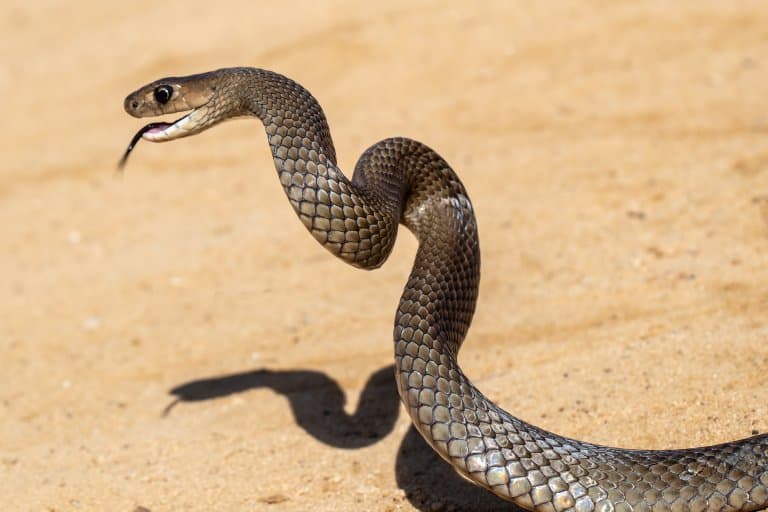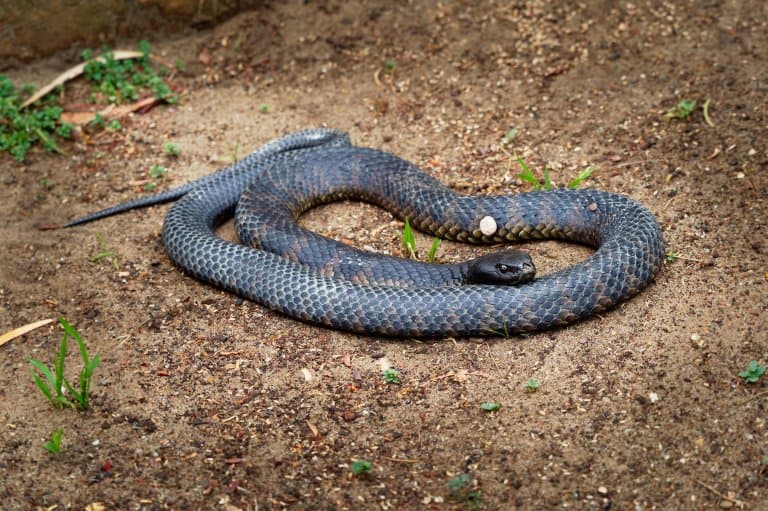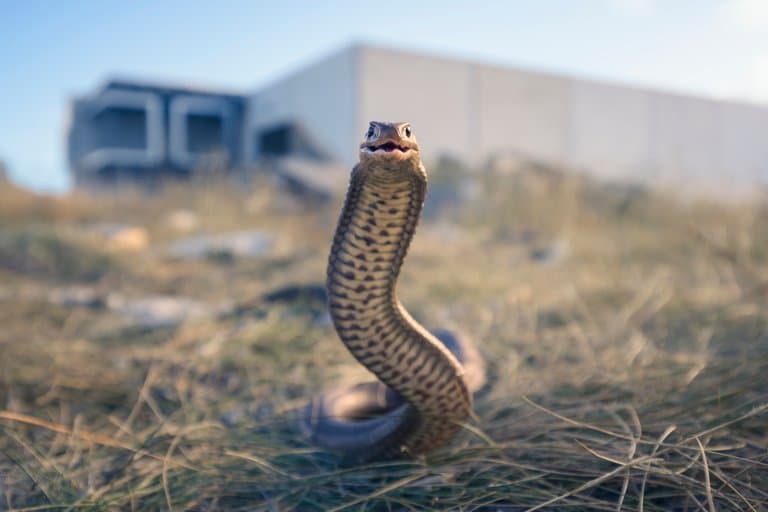Eastern Brown Snake Profile
Often in nature, the most innocuous can be the most dangerous. Amanita muscaria, the iconic and bright red and white mushroom, is relatively harmless when compared with its plain and lethal cousin, Amanita phalloides: a boring-looking fungus that contains the most deadly toxin of all mushrooms.
So, hearing the name brown snake should not lure you into a false sense of security. In fact, the mundane descriptor hides one of the most dangerous animals in the world.
The eastern brown snake, or common brown snake, is a species of highly venonmous snake native to eastern and central Australia, and New Guinea.

Eastern Brown Snake Facts Overview
| Habitat: | Commonly dry and arid environments, also urban areas |
| Location: | Australia and New Guinea |
| Lifespan: | Up to 7 years |
| Size: | Up to 2 m (6.6 ft) |
| Weight: | 7lb (3 kg) |
| Color: | Brown |
| Diet: | Small mammals: hares, rats, mice; juveniles will take skinks and other reptiles |
| Predators: | Feral cats, raptor birds |
| Top Speed: | Fast, but not recorded |
| No. of Species: |
1 |
| Conservation Status: |
Least concern |
The eastern brown snake doesn’t look particularly intimidating at first glance, and the name suggests leaf litter and teddy bears. However, get in close and you’ll notice that it does have that angry, mechanical glare, seen in cobras and tiger snakes.
It’s found in most habitats, often on the outskirts of urban areas, farmland, grasslands and coastal regions where it will shelter in hiding spots, rocks, or burrows.
Due to its diet, it can often be found close to houses and farms, which attract rodents such as the house mouse, skinks, small birds, eggs, and even other snakes which are preyed upon.
It has a slender build, and can grow up to around 2 m (7 ft) in length, and not always true to its name, it can vary in colour from dark brown to orange, with a pale cream and yellow underside.
These snakes are one of the deadliest on earth, and that definitely commands respect. But there’s plenty more about these misrepresented animals that make them interesting.
Interesting Eastern Brown Snake Facts
1. They are not always brown
The adult eastern brown snake is variable in color. The upperside of the snake can range from a true to name brown, to paler, russet, olive, orange, gray or near black.
Their undersides are paler, a creamy yellow colour.
Juveniles can vary further with different markings – their bodies can be uniform in color, have bands, or a reticulated pattern. These patterns fade with age into adulthood.

2. A dangerous fellow
Back in the day (in this case, 1943), when research papers had laxer linguistical restraints and writers could express a lot more personality in scientific their work (for better or worse), a paper on the brown snake by David Fray, an Australian naturalist, was published in The Victorian Naturalist.
In it, he describes catching snakes in Australia as a sport “par excellence”, and of all the snakes in his portfolio, he has:
“-no hesitation in placing this fellow at the head of the list for downright ferocity, speed, and lightening striking movements when chased and cornered… it is an affair fraught with grave danger to interfere on a hot day with an active brown snake”
Fray then goes on to list four “outstanding points of dissimilarity with its venomous brethren: 1
3. Its curious striking position
When defending itself – something which it has perhaps an unfair reputation for – the brown snake has been said to be able to hit bullets fired in its general direction.
This is, of course, not true. At least, not deliberately. A far more rigorous assessment of their defensive striking showed that firstly, brown snakes aren’t as easy to rile up as their legend suggests, but secondly, their strike speed was relatively slow at around 2 meters per second, or 4.5 mph.
However, its threat display, while reluctant, is impressive!
When the snake takes its threat seriously, it squares up, raising its head and more than a third of its total length off the ground. It curves its body, not flattening its head like other snakes, and facing its doe with its mouth open.
Being long and tall this way, they’re able to hit people well above the knee, avoiding snake boots and making them very dangerous to catch.
Though, during strikes, the brown snake is not very accurate; frequently missing, and only inflicts potentially dangerous bites in about 15% of cases. 2 3

4. The eastern brown snake constricts as well
The brown snake is unusual in its hunting style, too. Unlike many snakes that seem to hunt by smell, this one is commonly seen propping up its head on a long and erected neck to look around for food.
Hunting by vision isn’t something snakes are known for, so this is definitely different.
They eat almost exclusively vertebrates, mostly mammals, but with some reptiles, birds, and the occasional frog thrown in for good measure.
The brown snake’s habit of constricting makes its hunting technique strange. Constriction as a killing strategy isn’t unusual for snakes, but it’s almost always accompanied by a lack of venom.
In the Eastern brown snake, the victim is bitten, and then rapidly enveloped in coils, held still until the toxins do their work.
5. Its egg-laying habit
During the breeding season, males will battle it out for mates, fighting with the classic plaited rope style of the mamba and other long snakes.
After mating, females will lay around 16 eggs, though they can lay up to forty. Like pythons, they lay elongated, soft-shelled eggs, which they may or may not stick around to protect.
After 11 weeks, the juveniles will emerge, full of powerful venom and ready to kick some ass.
6. Its insistence on a dry, sunny, well-drained habitat
This perceived preference from Fray isn’t entirely accurate, though the snake does seem undeterred by temperatures and arid conditions that would make other animals shy away from hunting.
Still, they prefer to hunt in the cooler hours of the afternoon, and typically patrol hunting grounds that are no more than 100 meters from water.
Having said that, this is a versatile animal and does well in a multitude of environments, including urban ones. And this is where they come into contact with people. 4

7. They’re fast!
It’s not documented exactly how fast these snakes are, but they’re certainly nippy. Fray suggested that “it’s no exaggeration” that the brown snake is ten times the speed of its contemporaries.
He also said it could keep up with a fleeing human; despite his disclaimer, both claims are likely very much exaggerated
8. They are exceptionally venomous
Amid a sea of embellishments, at least one piece of this snake’s reputation holds true: it is a very dangerous fellow.
Its frenzied defence of its young, combined with the fact that it can sometimes choose to lay its eggs under your fridge and some of the most toxic venom known to science means that it is one of the top contenders for the world’s deadliest snake.
In Australia, the country best known for the most venomous snakes, it makes up a large proportion of the fatal snake bites, and are sometimes considered second only to the inland taipan in terms of most venomous land snake.
The venom itself is a heady mix of interesting neurotoxins, tissue toxins and coagulation factors, that combine to give the recipient some pretty terrifying symptoms such as haemorrhage seizures, kidney malfunction and cardiac arrest.
All of this can happen within the span of 30 minutes or so, and treatment needs to be received quickly. 5
9. They are responsible for 60% of fatal snake bites in Australia
While 80% of the top 10 most venomous snakes can be found in, or around Australia, the most deadly snakes are not Australian.
Of the total 81,000 to 138,000 human deaths each year, it’s estimated that 75% are in Asia, and over 50,000 of them are in the Indian subcontinent alone.
There are less than 500 snakebites with envenoming each year in Australia, and only 2-3 fatalaties each year. While thankfully a very small number, around 60% of those deaths come from bites of the eastern brown snake. 6
10. Antivenom can help victims recover
The venom of the eastern brown snake can cause convulsions, renal failure, paralysis, and cardiac arrest. When someone is suspected to have been bitten by an eastern brown snake, it is recommended that they remain as still as possible to limit venom spread.
Victims should seek medical care immediately, and be adminstered with the antivenom, which has been available since 1956.
Dogs and cats can also be treated equivalent of antivenom if bitten as well.
Eastern Brown Snake Fact-File Summary
Scientific Classification
| Kingdom: | Animalia |
| Phylum: | Chordata |
| Class: | Reptilia |
| Order: | Squamata |
| Family: | Elapidae |
| Genus: | Pseudonaja |
| Species Name: |
Pseudonaja Textilis |
Fact Sources & References
- David Fleay (1943), “The Brown Snake – Dangerous Fellow“, The Victorian Naturalist.
- William T. Avery (1953), “Mentem Mortalia Tangunt“, Classical Philology.
- Cecilie Beatson (2022), “Eastern Brown Snake“, Australian Museum.
- Elle Hunt (2017), “More than half Australian snake bite deaths since 2000 occurred at victim’s home“, The Guardian.
- Christopher I Johnston et al (2017), “The Australian Snakebite Project, 2005–2015“, Wiley.
- David Williams (2016), “Are Australian snakes the deadliest in the world? Not even close“, The Conversation.
